


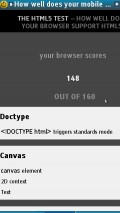
Click images to view full size.
Bitstream released a new version of the Bolt Java ME browser at the Mobile World Congress in Barcelona yesterday. It’s Bolt 2.5 and new features include support for more HTML5 features including the Geolocation API, the ability to play Facebook videos and some subtle tweaks to the UI that make it more touch friendly and reduce the number of clicks needed to perform common actions. Download Bolt 2.5 from: boltbrowser.com/dnld.html (PC) or boltbrowser.com/aindex (mobile web).
Like Opera Mini, Bolt is a proxy based browser. It’s written in Java ME and supports everything from basic feature phones to Symbian and bada smartphones. I installed Bolt 2.5 on four phones; a Nokia N8, Nokia N95-3, Samsung Wave GT8500L and a Motorola i776. Initially it didn’t work on the N8, It would hang when I tried to enter the Preferences screen. It locked up so tightly that the Symbian Task Manager couldn’t kill it and I had to power cycle the phone. But after I installed the PR 1.1 firmware update that Nokia released today for US model N8s Bolt ran fine. I ended up doing almost all of my testing on the N8 which is my main phone these days,
I was particularly excited about the inclusion of geolocation in Bolt. It worked very well on the N95 and the N8 but not on the other two devices. There’s supposed to be option to enable in the Preferences screen. That option was missing on the Wave and i776. I presume that means that Bolt didn’t detect support for the Java ME Location API (JSR 179). According to the spec sheet the Wave does support JSR 179. But a lot of things seem to be locked down on bada phones so perhaps Samsung has restricted access to the API however . But I don’t understand why location isn’t available on i776 as it does support JSR 179, even for unsigned apps, and many location aware Java apps do work on that phone.
I tried four location aware mobile sites on the two Nokias: Google Buzz, Never Eat Alone, Nextbus and the Organic Wine Finder (first three images below) and all where able to obtain my location quickly and correctly.

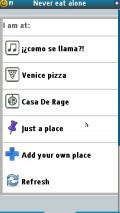


Click images to view full size.
The HTML5 support in Bolt is real and it does well on HTML5 test suites. I ran the W3C and Momac (image top right) HTML5 test pages in Bolt and the results speak for themselves. Bolt did very well.
| Bolt 2.5 | Android 2.2 Browser | Opera Mobile 10 | N8 Symbian Browser | Opera Mini 5.1 | |
| W3C (percent of tests passed) | 75% | 75% | 34% | 17% | 17% |
| Momac (number of tests passed) | 148 | 122 | 42 | 28 | 18 |
Bolt’s revamped UI has shallower menus and bigger text making it more touch friendly. I had no trouble using the menus and settings dialogs on the touch-only N8.
In real world browsing Bolt does a good job of rendering most sites including difficult ones like the desktop versions of Gawker and TechCrunch (first three images – top).
However I ran into issues with several of sites that I visit.
- On Engadget and the Haho Twitter client (last two images below) word wrap didn’t work correctly. Text columns were wider than the screen requiring horizontal scrolling across each line to read, which I consider un-acceptable.
- The Google homepage (3rd image, bottom) and YouTube defaulted to Italian even though I’m in the US, my phone has US firmware and the interface language is set to English.
- The iPhone/Android versions of Gmail and Google Reader were unusable because tapping an message or reader item doesn’t open it for reading as it should.
- On the N8 I found it impossible to toggle check boxes (like the second image in the bottom set) by tapping. The WordPress Dashboard uses hidden menus that are activated by a mouse over. That didn’t work either, making it impossible to select posts for editing or comments for moderation.

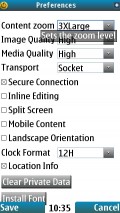

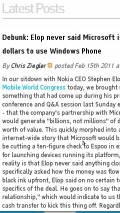
Click images to view full size.
In a move that’s likely to be controversial, Bolt is now inserting ads into web pages. All the ads that I saw were for a mobile portal called Wapdam. They appeared at either the top or the bottom of some but not all pages on Engadget, the Google homepage (last two images – bottom) and this blog.
I recognize that supporting a free proxy based browser is expensive and I’m OK with ads in apps including browsers. Many free browsers show ads on internal pages like settings dialogs or the bookmarks screen. Long ago Opera for the PC had ads in the toolbar area above the page. But Bolt is the first browser I’ve seen that inserts ads into 3rd party web pages. That makes the ads appear to be a part of the original page rather than a part of the browser.
The ads appear to be inserted in pages without the approval of the content owner. At least I was never contacted by Bolt about the ads on WapReview.com. This site is licensed under a liberal Creative Commons license which allows both commercial use and modification of content by third parties so I really can’t complain. Engadget, on the other hand, is copyright by AOL with “all rights reservered”. I wonder if Bolt has an agreement with AOL that allows them to insert the ads. If not I expect the fur to fly.
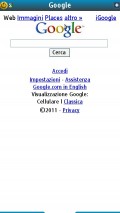

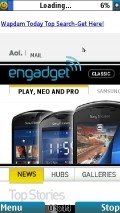
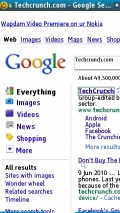
Click images to view full size.
In summary, Bolt is a powerful full-web proxy based browser with very good HTML5 support including support for geolocation. It runs on just about any phone with Java ME support including extremely basic feature phones like my Motorola i776. It generally handles large, complex web pages well although there are text wrapping issues with some. The ad wrapping strategy is a bold move. I’m curious to see how content owners will react to it.
But do those things actually work, or does it just report that it supports them without actually implementing the support for all those things? Don’t take scores like that at face value. It’s easy to cheat. And knowing Bolt’s history, that’s not exactly something Bitstream avoids doing.
On my SE W995 geolocation does not work. Never Eat Alone shows ‘Trying to get location and known places nearby’ but nothing happens. Bolt does not ask to use GPS and does not trigger it on – even with GPS turned on manually, nothing happens. And I am absolutely positive Location API is supported on device, other location-aware apps are working fine
The ads issue is definitely a problem seeing that it does not inform the user that the ads are by bolt, also positioning them right at that on random sites would drive some users away from the site its displayed on. Bolt should either display them at the bottom and label them bolt ads or intergrate them into the bolt user interface. There current implementation is basically saving there name at the expense of webmasters. Very nasty.
Pingback: Tweets that mention Bolt Browser 2.5 – HTML5, Geolocation, Improved UI and Ads | Wap Review -- Topsy.com